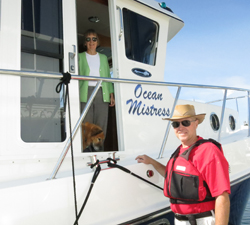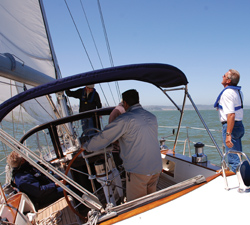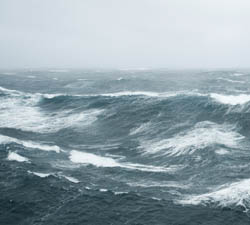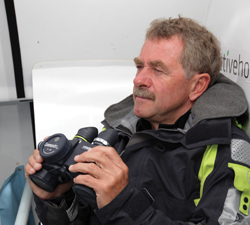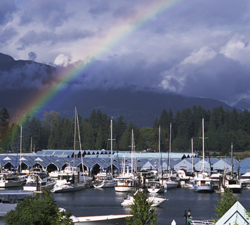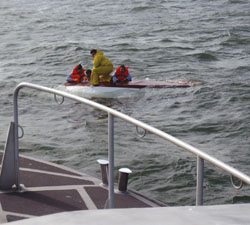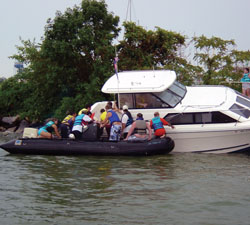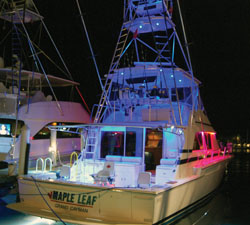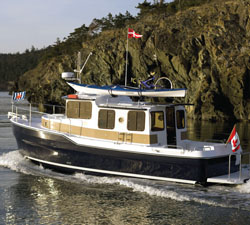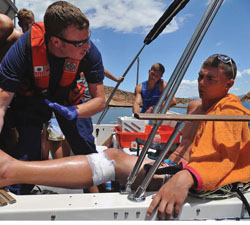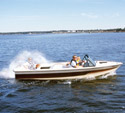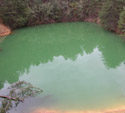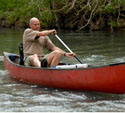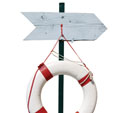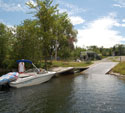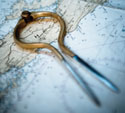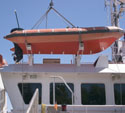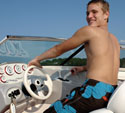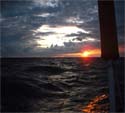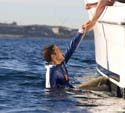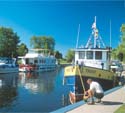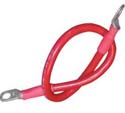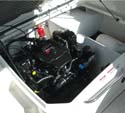March 8, 2013
Perfect Docking…Every Time
Effective communication is the key to smooth, stress-free docking. I am an extraordinarily lucky guy. My wife Corinne is the skipper of our American Tug 41, Ocean Mistress, and she loves and excels at her job! I am completely delighted when we bring the boat into a difficult docking situation and make the perfect no-fuss, no-stress landing. I’m even more tickled when folks on the dock see Corinne come out of the pilothouse and are surprised to learn that she just docked that big boat. She has received everything from whispered compliments to standing ovations.
February 6, 2013
Boating Ed
Whether you’re a novice or an experienced boater, nothing helps build competence and confidence like boating courses and instruction. There’s nothing like being out on the water, spending time with family and friends, letting the wind fill our sails and whisk us away to new adventures. Or if power is your preference, casting off and throttling up catch a few waves or discover a new destination.
January 4, 2013
Buying with a Yacht Broker
Whether you’re a new boater or an old salt, you have much to gain by trusting your boat search to a knowledgeable professional. I’m a bit of an evangelist when it comes to boats – I believe that if you’re lucky enough to live near water, salt or fresh, owning a boat is the true meaning of life. I’ve never given up the faith, but after owning the same 35’ sloop for 30 years, things had changed. With two teenage boys who had somehow grown big, the space aboard Sway had grown small.
September 17, 2012
Falling for Fall – Fall Cruising Tips
Summer may be fleeting but the rewards of autumn cruising include a slower pace, quieter destinations, surprisingly good weather, and maybe even a few thrills. The full moon rose big and bright, its track shimmering across the water into our anchorage near the head of Salt Spring Island’s Long Harbour. Golden lights winked on one by one in the cottages around the bay, reminding me that I wasn’t completely alone. After a precious sunny, almost-warm late-autumn day, it was one of the most beautiful evenings I’ve ever spent on the hook. It was also one of the coldest, for we had yet to install a heater in our 27’ sailboat Squid.
September 17, 2012
BC Sailing Leads The Way To Safer Racing
The golden thread that links the aftermath most offshore and distance sailing accidents is the absence of formal safety and survival training. Despite the overwhelming body of evidence that supports that conclusion, North American sailors have been slow to embrace the idea that taking a course and learning how to right a capsized liferaft, proper tether and harness discipline, or how to retrieve a crew overboard from the water is just as important as investing time to teach how to tack without losing boat lengths. For racers it boils down to this: you cannot place if you don’t finish.
May 2, 2012
Financing Your New Boat
2012 is the Year of The Boat Buying Trifecta: Low Interest Rates – High Canadian Dollar – Low Global Boat Prices. We think that the 2012 will be the year of the boat buying trifecta; we have record low interest rates, a high Canadian dollar, and low global boat prices making the yacht of your dreams more affordable and closer to reality than we ever remember before. With rapidly escalating numbers of Canadians reaching retirement age, many of whom are already smart enough to have realized this opportunity, the Canadian boat market is alive and well while markets in most other countries are stagnant or down.
April 27, 2012
Marine Binoculars: A Shopper’s Quick Guide
While the Office of Boating Safety, Transport Canada surprisingly does not list binoculars as part of its mandatory safety equipment, we would suggest that having a good pair on board just makes good sense. Binoculars designed specifically for marine use are traditionally stronger in structure and are, of course, waterproof – or should be. In fact, some models even float. Today, we are going to highlight the key criteria for selecting a pair of binoculars as well as share a few neat features and accessories.
April 26, 2012
Great Resources for How to Weather the Weather
I’ve been a pilot for 37 years and spent 28 years flying passenger aircraft for the airlines – you can bet that the weather was always one of my foremost concerns. I’ve retired from the airlines, but my interest in the weather, in forecasting weather and in all of the available resources to help me plan a safe journey, are just as important as ever. It’s still a matter of my personal safety, the safety of my loved ones and my friends, except now, I’m at the helm of my own boat.
March 21, 2012
Starting – A System To Help You Get Off The Line With Confidence
Discipline is paramount in implementing a total starting strategy for each and every boat race. Without a sound understanding of the procedure by every team member on a boat, and allowing time to gather information before the start of every race, your chances of making well calculated decisions are substantially reduced. Many different sailors and teams have their own ideas and plans for the start of the race. The guide outlined here is a system that works well for me and you may find that modifying this works better for you – but the only way to establish this is to start practicing and sticking to a plan from the outset.
March 6, 2012
Have More Fun Next Summer With Greater Knowledge
Even if you were born on board a boat, there’s probably more knowledge and skills you could gain to help you have more fun next summer. Whatever your interest might be, whether you are a novice hoping to get started or you’re already an expert, there are many learning resources available. At Canadian Yachting magazine, one of our most important partnerships is with the Canadian Power and Sail Squadrons (CPS). If you’re new to boating and don’t know about CPS, they are a national organization, operating in both official languages and they are all about boating knowledge.
October 18, 2011
Surviving a Capsizing
Capsizings resulted in many recreational boating deaths and injuries in 2010. Practice good seamanship to reduce your risk of capsizing, but if it happens know what to do to ensure that everyone on board gets back safely. If you and your passengers are not wearing life jackets when the boat capsized, try to retrieve any equipment or gear, such as coolers or seat cushions, and improvise flotation. Never attempt to re-enter a capsized vessel. Then consider the most appropriate means to summon help.
October 18, 2011
5 Key Factors in Ensuring a Safe Rescue
This past May, Coast Guard surface and air crews conducted an all-night search of the Great Peconic Bay area of Long Island, NY, for a possible missing kite surfer after gear was found floating in the water. The search was suspended after news reports prompted the owner to call to say he was safe. Coast Guard patrols often encounter abandoned and adrift boats and gear. If there is even a small chance a person is in the water, the Coast Guard undertakes search and rescue efforts. If you should find yourself in trouble, here are five actions you can take to increase the chances Search and Rescue will get to you in time.
October 18, 2011
Lighting the Way
So, who’s afraid of the dark? Well, some boaters should be. We were surprised to walk down the docks at one of Georgian Bay’s popular marinas and found that as many as one boat in five didn’t have a bow mounted spot. How often have you seen the weather settle down, the clouds part and the winds die down to give you an evening of beautiful, calm, sunset cruising conditions? Where I live, it’s pretty common.
October 18, 2011
Flag Etiquette: Flying Flags and Pennants Properly
A number of weeks ago I received an e-mail from a Canadian who owned and operated a recreational boat in the U.S. The boat, for the most part, stayed in U.S. waters and was licensed in a U.S. State. The owner wanted to know where he could fly a Canadian flag to indicate his citizenship. The simple answer was that he could not, if he was operating in U.S. waters. The National flag indicates the Country of registry, or where the boat is licensed, in this case the U.S. A courtesy flag indicates where the vessel is being operated, for the most part, also the U.S. These flags do not indicate the citizenship of the owner/operator.
August 23, 2011
First Aid and Hero Training
No one plans for an accident to happen while boating, but if it did, are you prepared? Is there a first aid kit on board? Is it easily accessible and fully stocked? Does anyone on board even know how to use it? Could you be the hero, or will you be just a bystander? Safety can be a hard sell. In Vancouver, Western Marine Company’s Alan Stovell said simply, “There is no requirement for first aid kits for recreational boaters.” He points out while commercial boaters must abide by strict regulations based on the crew and voyage there are no such restrictions for pleasure boaters in Canada, although it’s certainly recommended.
July 12, 2011
Travelling South of the Border
For those of you who boat south of the border, the following information bulletin was recently issued by U.S. Customs and Border Protection regarding a new program to permit easier entry of pleasure craft into the U.S. “The Small Vessel Reporting System (SVRS), a voluntary program offered by U.S. Customs and Border Protection (CBP), helps boaters report their arrival to the U.S. at no charge. The program is designed to expedite entry of legitimate boaters,
January 5, 2011
Insidious Carbon Monoxide
It’s difficult to comprehend that when we head out on the open water, with a fresh breeze, clear air and nary a boat nearby we could be a victim of something we usually associate with confined spaces and poor ventilation–Carbon Monoxide (CO). Onboard our vessels, we have a few potential sources of CO such as gasoline-powered engines and generators and propane cooking and heating appliances. Exhausts should dissipate harmful gases away from the boat, however experts in occupational health and safety, search and rescue and ambulatory care are identifying emerging issues for boaters.
December 30, 2010
The Aids To Navigation System
There’s nothing like that picturesque lighthouse flashing a light on a high cliff with pounding surf on the rocks below it. That large bell buoy clanging away in the swell just offshore from the breakers crashing on a shoal and the groaning foghorn blaring through the heavy mist to warn of landfall somewhere in the pea soup. Those certainly are the traditional icons we may all imagine when mention of aids to navigation is made but are they accurate in today’s technical world? And not withstanding today’s technology, how did and do the traditional aids actually help a mariner navigate safely?
December 23, 2010
“Water” Safety
Many of us unwittingly know a few words of Samuel Coleridge’s epic poetic story, The Rime of the Ancient Mariner. The words that are often quoted, though their source is seldom acknowledged, refer to being far away on the briny ocean tossed and go like this: water, water everywhere, ne any drop to drink.
December 17, 2010
Safety On Board
Transport Canada regulations require vessels to carry a variety of life saving equipment for use in emergencies. Make sure you know where this equipment is stored, and how to use it. For specific regulatory requirements, check the regulations that apply to your vessel. The Small Vessel Regulations set out the minimum safety equipment required on board a recreational boat according to vessel length.
November 4, 2010
The Art of (Paper) Charts
They decorate cottage walls, get lacquered into table tops, may have coffee stains, probably have water stains, are definitely creased, sometimes rolled and always informative. They are usually only printed with a few colours of ink, mostly one sided, regularly cover about 12 sq. ft. and are chock-a-block full of details for navigation and often inscribed with an ‘X’ that marks the spot.
June 2, 2010
Can You Canoe?
The canoe. Now that’s Canadian. They have been part of the landscape from since native North Americans plied the waterways to now being one of the most economical and accessible ways to get out on the water and explore. They seem simple enough – grab a paddle and go. Eagerly purchased, usually incompletely outfitted and almost never really understood or mastered. After a season or two, many a forgotten canoe can be found behind garage’s, under porches at cottages or at the boat ramp, gathering critter droppings and moss. But every once and a while a desire to get out on the water arises and someone remembers the Canadian icon, ignominiously hidden away. They haul it out, grab a paddle and go.
June 1, 2010
Make (Safe) Mistakes – Build Experience
The best thing that can result from an accident: we (hopefully) learn from our mistake. Perhaps even better is when someone else has the accident and we learn from his or her mistake! I have spent many years on the water and in as many different roles – like everyone, a recreational boater, like many, a sailing instructor and, like a few, in charge of a Search and Rescue unit.
May 21, 2010
OPG Warns Boaters About Low Water Levels
Ontario Power Generation (OPG) is reminding people that water levels on many lakes and rivers are much lower than normal for this time of year. “Most of the province had lower than normal snowfall, and April was one of the driest on record. This means that people going to their cottage or putting their boat in the water may see very low water levels,” said John Murphy, OPG’s Executive Vice President Hydro.
May 18, 2010
Get Lost
Most of us usually go boating on waters with which we are familiar, leaving the wharf of mooring where the boat is usually kept and heading off for the day, maybe even an overnighter. Sometimes we may plan a trip that takes us away from our home waters and venture into the unknown – the other side of the bay, up the coast or down the river to another lake. When we do, prudence means we have the right tools for navigation – at minimum: a compass and charts, perhaps a depth sounder, a GPS unit, maybe even a radar unit, probably not a sextant but hopefully a log book. It is with these tools and proper practices that prevent you from getting lost.
May 17, 2010
Don’t Panic!
Two simple words really. We’ve all heard ’em. Sound pretty d’urn simple – at least in practice. Of course, when things go south keeping a level head or a steady hand are easier said than done. And if worse comes to worst, panicking makes it even…worse, if that’s possible.
May 11, 2010
Your Turn on the Wheel
No lines, no intersections, no stoplights, no gridlock. The water – the place to get away from it all. There is enough of it in Canada that it really is hard to find a congested waterway. Sure, they exist and if you chose to go where everyone else thinks is the place to go on that day, then you’ll find it. But there are so many choices of destinations and so many ways to get there that if you plan well, you can surely feel like you are alone in the middle of nowhere and let your troubles, your worries and your responsibilities slip away. Hold on – not all of your responsibilities. As captain of the vessel, you are legally responsible for the operation of the craft and the safety of the crew and passengers on board.
April 29, 2010
The Little Red Boat That Could – And Does!
There are many types of boats – the sleek racing ones, the comfortable cottage-on-the-water ones and the purely functional ones. Ours recently got a rich red paint job, some TLC and a new 15 hp 4-stroke. . It’s not that pretty but in function not much can compete with it. It spends winters under a roof and out of the snow. It gets family and friends out to an isolated island in the North Channel of Lake Huron. I call it our container ship – although really an oversized rowboat – considering the loads it takes out to this isolated haven and the speed at which it travels. Its 16-feet long, steel, tough, heavy, flat-bottomed, stable and fondly known as a “Tilbury”.
November 14, 2009
Overnight Passage Making
Every trip, whether it is a day trip, series of day trips, single or multiple overnight trips, will consist of three primary areas of activity: Pre-departure planning, the trip itself and post trip follow up. Let’s start with the planning.
November 14, 2009
Man Overboard
An accident that occurs with surprising frequency to passengers and crew is falling. The chance of this happening can be greatly reduced if precautions are taken, such as wearing non-skid shoes that lace up and wearing appropriate clothing that does not impede movement. Those on board should make sure they have a sound footing and a good handhold at all times.
November 14, 2009
Canals and Locks
Waterways across the country where locks have been built to assist navigation are the St. Lawrence Seaway, the Trent-Severn Waterway (including the Murray Canal), the Rideau Waterway, the Ottawa River, the Richelieu River, the St. Peter’s Canal and the Canso Canal. Regulations and information regarding these waterways can be obtained from government offices and the lockmasters.
November 14, 2009
Docking and Undocking
Getting the boat away from the dock can sometimes be challenging if the wind and current are contrary and other boats are nearby. With inboard and inboard/outboard engines, the bilge blower must be turned on for a minimum of four minutes to clear away any explosive fumes that may have collected. The size of the engine does not determine how long you need to turn on the blower to clear the bilge of potentially dangerous fumes but rather the volume of the bilge. The more volume the more time is required.
November 14, 2009
The Art of Anchoring
Why anchor? Well let’s start with the simple fact that unless a boat is secured, it will drift away due to the actions of wind, wave action, tide and/or currents. If a boat cannot be attached to something secure such as a dock, piling, mooring buoy, tree, or rock, it must be anchored. There is much more to anchoring than simply tossing the anchor over the side.
November 14, 2009
Eye Protection for Boaters
It happens every year. The minute the thermometer reaches over 10 or 12 degrees you see them. Canadians emerge from winter hibernation. Yes! Finally the warm sun is back again! Venturing out, we usually think of the sunscreen with the best SPF money can buy, and perhaps a hat … as long as it doesn’t cramp our style, and sunglasses … again something stylish. But little thought goes into why these are necessary.
November 14, 2009
Fire Systems
Engine room fires are mercifully rare, but every so often, one does occur. The engine room is the most likely place on your boat for a fire to get started and if the fire breaks out while you are out on the water, the lives of everyone on board are at risk.

